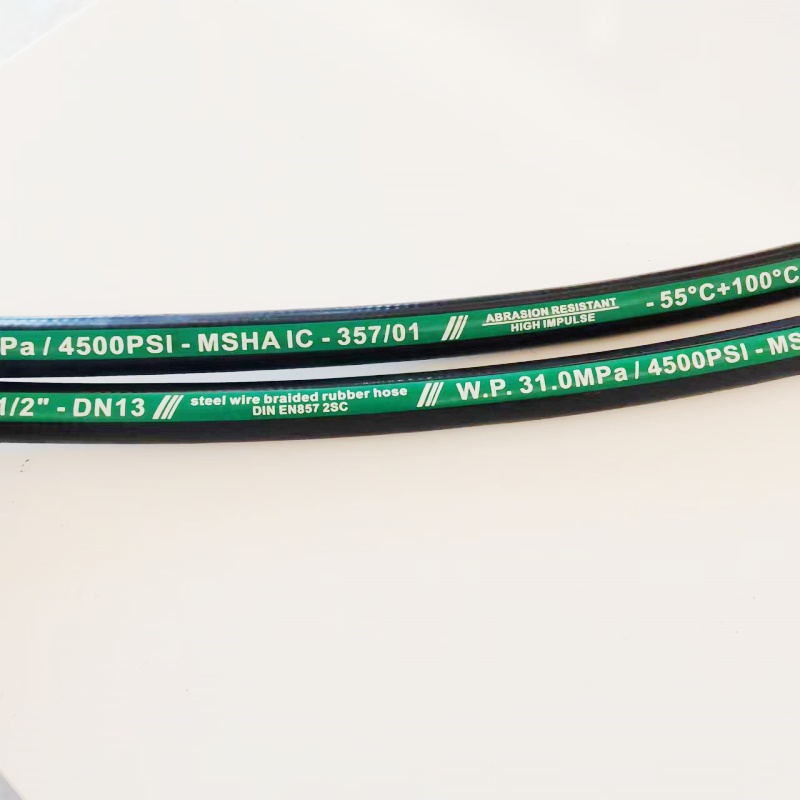335345435
Nov . 12, 2024 13:22 Back to list
twin hydraulic hose
Twin Hydraulic Hose An Essential Component for Fluid Power Systems
In the realm of fluid power systems, bridges, heavy machinery, and automotive applications, efficient fluid transfer is crucial. This need has led to the development of various types of hydraulic hoses, among which twin hydraulic hoses have gained significant recognition for their unique design and functionality. This article delves into what twin hydraulic hoses are, their advantages, applications, and maintenance considerations.
Understanding Twin Hydraulic Hoses
Twin hydraulic hoses consist of two parallel hoses that are bonded together. This configuration allows for ease of installation and a reduction in space requirements within machinery and systems. Typically, the hoses are made from synthetic rubber and reinforced with materials such as steel wire or textile, ensuring durability and resistance to high pressures and temperatures. Depending on the application, these hoses can transport a wide variety of hydraulic fluids, including hydraulic oils, water-based fluids, and even some corrosive substances.
Advantages of Twin Hydraulic Hoses
1. Space Efficiency The parallel design of twin hydraulic hoses allows for a more compact installation. This feature is particularly beneficial in tight spaces where traditional hoses might be cumbersome or impractical. The reduced footprint can lead to lighter equipment and less material usage.
2. Reduced Installation Time Since two hoses are bundled together, the installation process is notably quicker and easier. This efficiency not only saves time but also reduces labor costs associated with setting up hydraulic systems.
3. Improved Flexibility Twin hydraulic hoses generally possess better flexibility than traditional single hoses. This characteristic makes them ideal for dynamic applications where movement is required, such as in robotic arms or mobile machinery.
4. Increased Safety By combining hoses, the likelihood of tangling or kinking is reduced, which can minimize the risk of hose failure and potential accidents. Additionally, the robust design of twin hoses offers enhanced protection against bursts and leaks.
Applications of Twin Hydraulic Hoses
twin hydraulic hose

The versatility of twin hydraulic hoses enables them to be used in a myriad of applications across different industries
- Construction Equipment In heavy machinery, such as excavators and loaders, twin hydraulic hoses are vital for operating hydraulic systems for lifting, digging, and other functions.
- Agricultural Machinery Tractors and combines utilize twin hoses to control various attachments, ensuring efficient operation in the field.
- Automotive Systems In the automotive industry, these hoses are used in braking systems and power steering, allowing for smooth operation and responsiveness.
- Industrial Manufacturing Twin hydraulic hoses are frequently employed in manufacturing equipment, especially in environments where space is limited but high pressure is needed.
Maintenance Considerations
Maintaining the integrity and functionality of twin hydraulic hoses is essential for operational efficiency and safety. Regular inspection for signs of wear, such as cracks, bulges, or leaks, is crucial. Operators should also ensure that fittings are secure and free from debris. Additionally, understanding the specific fluid compatibility and operating pressure ratings is fundamental to preventing hose failure.
Proper storage of twin hydraulic hoses, away from extreme heat or direct sunlight, can significantly extend their lifespan. Implementing routine maintenance practices not only enhances the reliability of the hydraulic system but also reduces the potential for costly downtime and repairs.
Conclusion
Twin hydraulic hoses play an indispensable role in modern hydraulic systems, offering advantages that enhance efficiency, safety, and ease of use. Their design allows for space-saving applications without compromising performance, making them a preferred choice across various industries. As technology continues to advance, the role of twin hydraulic hoses will undoubtedly evolve, paving the way for even more innovative solutions in fluid power systems. Embracing this technology will enable industries to operate more efficiently while maintaining safety and reliability.
-
SAE 100 R17 Black Smooth Cover Hydraulic Hose
NewsMar.07,2025
-
SAE 100 R17 Black Smooth Cover Hydraulic Hose
NewsMar.07,2025
-
SAE 100 R17 Black Smooth Cover Hydraulic Hose
NewsMar.07,2025
-
SAE 100 R17 Black Smooth Cover Hydraulic Hose
NewsMar.07,2025
-
SAE 100 R17 Black Smooth Cover Hydraulic Hose
NewsMar.07,2025
-
steel wire braided hydraulic hose
NewsMar.07,2025



